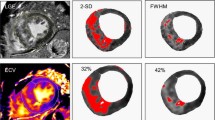Abstract
Background
QT dispersion reveals heterogeneities in the repolarization time in the three-dimensional (3D) structure of the ventricular myocardium. In this study, we report on a 3D function map of recovery time (RT) dispersions as measured by 64-channel magnetocardiography (MCG).
Methods
MCG were simultaneously recorded in 29 controls and 21 patients with previous myocardial infarction (MI). The 3D current density was calculated from 64-channel MCG data in the B z component using a space filter. The heart outline, reconstructed from the integrated the current density, revealed both the atrium and ventricle. The RT for the intervals between QRS onset and the time of the maximum dT/dt of T wave, and the peak to the end of the T wave (Tpeak-negative dT/dt) were automatically measured by means of a computer from 3D MCG data. The corrected RT (RTc) and corrected Tpeak-negative dT/dt were then calculated using Bazett’s formula. The 3D RTc and the corrected Tpeak-negative dT/dt dispersion map were superimposed on the heart outline generated by MCG.
Results
The RTc was significantly longer for the MI group than in the control group (67±25 ms1/2 vs. 16±6 ms1/2) (p<0.0001). The corrected Tpeak-negative dT/dt dispersions in each patient was also significantly longer for the MI group than in the control group (35±27 ms1/2 vs. 10±5 ms1/2) (p<0.0001). Furthermore, the 3D RTc and Tpeak-negative dT/dt dispersion maps corresponded with the space location of MI, as defined by Tc-99m tetrofosmin myocardial imaging
Conclusions
3D RTc and Tpeak-negative dT/dt dispersion maps in the ST segment, obtained by 64-channel MCG may be used demonstrate the location of a myocardial injury and heterogeneities of repolarization.
Similar content being viewed by others
References
Cohen D, Edelsack EA, Zimmaerman JE. (1970). Magnetocardiogram taken inside a shielded room with superconducting point-contact magnetometor. Appl Phys 16:288–94
Fenici R, Brisinda D, Nenonen J, Fenici P. (2003). Phantom validation of multichannel magnetocardiography source localization. Pacing Clin Electrophysiol 26:426–30
Tukada K, Mitsui T, Terada Y, Horigome H, Yamaguchi I. (1999). Noninvasive visualization of multiple simultaneously activated regions on torso magnetocardiographic maps during ventricular depolarization. J Electrocardiol 32:305–310
Nakai K, Kawazoe K, Izumoto H, et al. Construction of a 3D outline of the heart and conduction pathway by means of a 64-channel magnetocardiogram in patients with atrial flutter and fibrillation. Int J Cardiovasc Imaging 2005; 21: 555–561
Fuster V, Badimon L, Badimon JJ, Chesebro JH. (1992). The pathogenesis of coronary artery disease and the acute coronary syndromes (2). N Engl J Med 326:242–250
Fayad ZA, Fuster V, Nikolaou K, Becker C. (2002). Computed tomography and magnetic resonance imaging for noninvasive coronary angiography and plaque imaging: current and potential future concepts. Circulation 106:2026–2034
Shimizu W, Antzelevitch C. (1999). Cellular and ionic basis for T-wave alternans under long-QT conditions. Circulation 99:1499–507
Yan GX, Shimizu W, Antzelevitch C. (1998). Characteristics and distribution of M cells in arterially perfused canine left ventricular wedge preparations. Circulation 98:1928–1936
Tikhonov AN, Arsenin VY. The regurarization method. In: Solution of III-Posed Problems. Washington, DC: VH Winstin & Sons, 1977; 45–94
Pasola K, Nenonen J, Proceedings of 12th International Conference on Biomagnetism 2001, 835–838
Nenonen J, Pesola K, Hanninen H, Lauerma K, Takala P, Makela T, Makijarvi M, Knuuti J, Toivonen L, Katila T. (2001). Current-density estimation of exercise-induced ischemia in patients with multivessel coronary artery disease. J Electrocardiol 34:37–42
Malik M, Batchvarov VN. (2000). Measurement, interpretation and clinical potential of QT dispersion. J Am Coll Cardiol 36:1749–66
Faber TS, Kautzner J, Zehender M, Camm AJ, Malik M. (2001). Impact of electrocardiogram recording format on QT interval measurement and QT dispersion assessment. Pacing Clin Electrophysiol 24:1739–1747
Nirei T, Kasanuki H. (2001). Recovery time dispersion measured by body surface mapping: noninvasive method of assessing vulnerability to ventricular tachyarrhythmias. J Electrocardiol 3:127–33
Matsuo K, Shimizu W, Kurita T, Suyama K, Aihara N, Kamakura S, Shimomura K. (1998). Increased dispersion of repolarization time determined by monophasic action potentials in two patients with familial idiopathic ventricular fibrillation. J Cardiovasc Electrophysiol 9:74–83
Acknowledgments
This study was supported by a grant from the Joint Research Project for Regional Intensive in Iwate Prefecture, the Keiryokai Foundation (No.88) of Iwate Medical University, and Open Research Translational Research Center Project, Advanced Medical Science Center, Iwate Medical University.
Author information
Authors and Affiliations
Corresponding author
Rights and permissions
About this article
Cite this article
Nakai, K., Izumoto, H., Kawazoe, K. et al. Three-dimensional recovery time dispersion map by 64-channel magnetocardiography may demonstrate the location of a myocardial injury and heterogeneity of repolarization. Int J Cardiovasc Imaging 22, 573–580 (2006). https://doi.org/10.1007/s10554-005-9019-x
Received:
Accepted:
Published:
Issue Date:
DOI: https://doi.org/10.1007/s10554-005-9019-x




